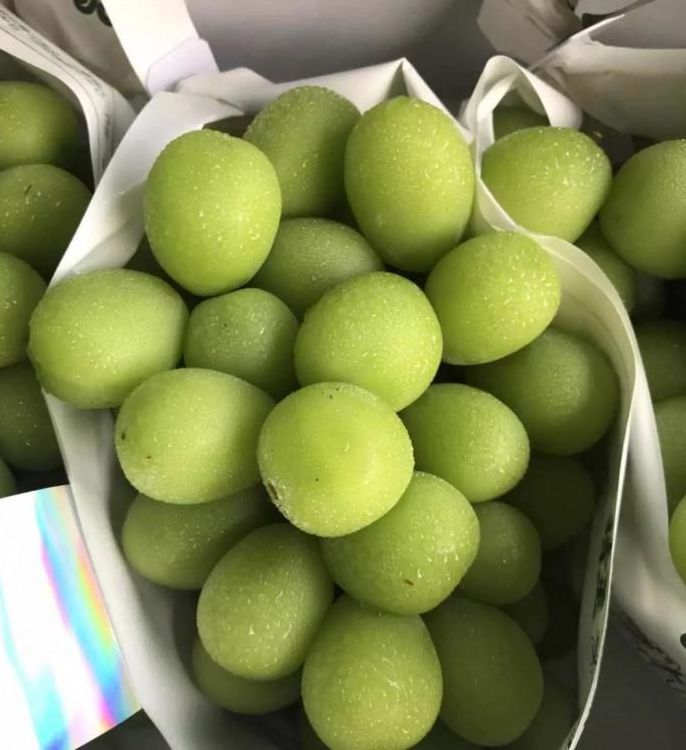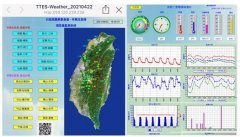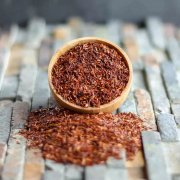Sunny Rose King shine-muscat Grape prices plummeted
The name of shine-muscat is Qingwang in Japan and Sunshine Rose in China. Once the price was 500 yuan per jin, it has been introduced for only 6 years since 2015. Its market price is 10 yuan, which is a good thing for the market. For most farmers, it is another useless effort. And this is the same problem that most of the agricultural products that form the industry are facing. When prices are high, large-scale introduction, policy guidance for mass planting, planting mu as the king, and so on, when everyone's efforts blossom and bear fruit, prices fall off the altar. This pattern has appeared on coffee in Yunnan, on Sunshine Rose in Yunnan, and on macadamia nuts in Yunnan, because Yunnan pulled macadamia nuts from tens of thousands of mu to millions of mu just a few years ago. it will take some time for the market to digest and allocate this capacity.
Since last year, all kinds of grape varieties have appeared in Shangchao, among which "Jufeng", "Summer Black" and "Sunshine Rose" are still the mainstream varieties. However, a reporter from the Beijing News country Channel noticed that the price of the so-called "high-end grapes" represented by Sunshine Rose grapes has continued to decline in recent years. The reporter visited Shangchao in Beijing and found that sunshine roses, which were often worth hundreds of yuan in previous years, sold for only 16 yuan per jin when the price was the lowest in August this year. Behind the drop in prices is a sharp increase in acreage. Wang Haibo, an expert at the Institute of Fruit trees of the Chinese Academy of Sciences, said that at present, the planting area of "Sunshine Rose" has reached 800000 mu, compared with only tens of thousands of mu in 2016. Although prices have plummeted, so that farmers who follow the trend can not see the "sunshine," Wang Haibo also said that growers need not worry. The way out now is not to continue to expand output, but to "control production and increase quality." sunny roses of good quality can be sold at high prices even when a large number of them are on the market.
100 yuan per jin dropped to 16 yuan.
Sunshine rose is a variety introduced from Japan, the country of origin is Okayama Prefecture, Japan, is also a new network celebrity grape variety in recent years, delicate taste, sweet taste, full fruit. The price is much higher than the common giant peak, rose fragrance, red lift and so on, and it is known as "Herm è s in Qingti".
At the beginning of its introduction, the grape sold for as much as 500 yuan per bunch in Japan, with an average price of 10 yuan per grape. In 2010, China began to introduce Sunshine Rose, and it was not until around 2015 that this grape gradually came into public view. At the beginning of entering the supermarket, the price was once 300 yuan per jin, and then the price decreased slightly with the increase of production, but it also hovered at 100 yuan per jin. Driven by high prices, more and more farmers began to plant sunny roses, but this also led to its price becoming more and more close to the people.

This year, the price trend of Sunshine Rose Grape has changed so much that consumers do not understand it. Yunnan Province is the earliest place in the country to list Sunshine Rose, which can be booked online in May at a price of about 100 yuan per jin. In June, sunshine roses from Sichuan, Zhejiang and other places also began to appear on the market. With the increase of listing volume, the price of Beijing Shangchao quickly dropped to about 30 yuan per jin. Since August, a large number of sunshine roses have been on the market, and the price of Shangchao in Beijing has dropped to about 16 yuan per jin, while this year, it has dropped to 8 yuan per jin.
According to Red Star News, it is the season for Sunshine Rose grapes. Xichang City, Sichuan Province, as the "hometown of late-ripening grapes in China", with a grape planting area of more than 100000 mu, is the area with the largest number of sunny roses in Sichuan Province.
On August 18, the Sunshine Rose grapes in Yonghui supermarket in Xichang sold for 8.98 yuan per jin. Photo Source: red Star News
On the morning of August 18, Ms. Yang, a tourist from Chengdu, bought 20 jin of Sunshine Rose grapes at the Changan Agricultural Trade Wholesale Market in Xichang City, which she was going to take home to share with relatives and friends. The purchase price was only 10 yuan per jin, which surprised her: "is this the Sunshine Rose Grape I know?" She first came into contact with this variety in 2016, and the price of participating in group buying was as high as 100 yuan per jin. At this time last year, I bought Sunshine Rose grapes in Xichang. The price was 18 yuan per jin. I didn't expect the price to be so much cheaper this year.
This year, the price of Sunshine Rose Grape continues to decline sharply, and fruit sellers are also deeply impressed. "Last year, the price of Sunshine Rose grapes with better quality sold for more than 40 yuan per jin, while this year the highest price was no more than 20 yuan." Ms. Yang, a fruit wholesaler in Xichang, told Red Star News that compared with last year, the price of Sunshine Rose Grape was nearly halved this year. "although the price has dropped, there are people selling Sunshine Rose Grape everywhere, the competition is very big, and the market is not ideal."
China's planting area expands rapidly
Sunshine Rose, a green variety from Japan, is called "Herm è s in grapes" because of its green appearance, sweet taste, but high price. In Japan, the average price of a bunch of (500g) sunshine roses ranges from 2000 yen to 3000 yen, while gift-grade high-end sunshine roses can reach 10, 000 yen (about 600 yuan).
In 2010, China began to introduce sunshine roses, but it was not until around 2015 that it gradually entered the public view. At first, the price of Sunshine Rose Grape was 300 yuan per jin when it entered the supermarket. Later, with the increase of production, the price decreased slightly, but hovered around 100 yuan per jin. However, since 2020, the price of this variety has dropped to dozens of yuan per catty in the domestic market, and even dropped to three or four yuan per catty in some areas.
This is mainly related to the rapid increase of the planting area of Sunshine Rose Grape in China. According to the Institute of Fruit trees of the Chinese Academy of Sciences, the planting area of sunshine roses in China has reached 800000 mu in 2020, and is still expanding, and is expected to exceed 1 million mu in 2021. In 2016, the planting area of Sunshine Rose Grape in China is only tens of thousands of mu.
According to the Nippon Keizai Shimbun, after the Japanese breeding brand Sunshine Rose was introduced into South Korea and China, the sales scale and output scale of Sunshine Rose has far exceeded that of Japan. In South Korea, Sunshine Rose has become the main exporter of Korean fruit, the export volume has increased to nearly five times that of Japan, and the planting area of Sunshine Rose in China has reached more than 40 times that of Japan.
Japan lost its "control" of Sunshine Rose Grape
It is worth noting that the outflow of products from Japanese brands such as Sunshine Rose has attracted the attention of the Japanese government.
In April this year, the Japanese government began to implement a new "seedling law" that prohibits registered varieties from being taken overseas. The new regulations prohibit individuals and legal persons from bringing registered seeds and seedlings of Japanese agricultural products out of Japan without permission. Seeds of the relevant varieties shall not be collected for planting without the permission of the brand owner; if these seeds and seedlings are taken out of Japan illegally, they will be sentenced to less than 10 years' imprisonment or a fine of less than 10 million yen. In the case of a legal person, a fine of less than 300 million yen will be imposed.
However, it is difficult for this new law to work on Sunshine Rose.
According to the interface news report, agricultural breeding requires high manpower and time costs. Data show that Japan's local apples, oranges, peaches and other common fruit trees, the average time to cultivate new varieties is 24.5 years. Therefore, most of the common new varieties of fruits in Japan have intellectual property protection or even applied for brands to protect the rights of developers.
But earlier, there were some loopholes in the overseas export of Japanese seeds and saplings.
Take Sunshine Rose Qingti, for example, this variety applied for intellectual property protection in Japan in 2006, but the government did not make an export decision at that time, nor did it apply for variety registration protection overseas. According to Japan's earlier seedling law, seeds or saplings can be taken to countries or regions that have joined the relevant international treaties on the protection of seedlings, so South Korea and China have also introduced sunny rose varieties and began to plant them in large quantities.
When the Japanese side is aware of this problem, it has missed the deadline for overseas applications for intellectual property protection, so the so-called "infringement" of fruit seedlings is also difficult to define in law.
Not only sunshine roses, but the Japan Agriculture, Forestry, Fisheries and Food Industry Technology Revitalization Association found in 2020 that more than 30 Japanese breeding fruit varieties had been taken overseas earlier, such as Shizuoka's "beauty" strawberries and "Hongmei" oranges. Saga's "fragrant" strawberries and so on.
- Prev

Establishment of Tea production Management Information platform for Tea conversion Plant Management of EASY for Tea Garden
The Tea Industry improvement Farm (Tea improvement Farm for short) has set up a "Tea production Management Information platform" to provide immediate, historical and early warning meteorological data of major tea areas in Taiwan, as well as monthly update of management information of 10 tea gardens in five major tea areas. provide including the current growth status of tea trees, estimation
- Next

The price of the "national treasure tea" of South Africa's three treasures has risen after it has been certified by the European Union.
South Africa's national treasure tea, which is rich in natural nutrition and free of caffeine, has become very popular in the beverage market in recent years. In May this year, it was certified by the European Commission and protected by its name of origin, making it the first crop in Africa to obtain this certification, which means that even with the same use.
Related
- A one-day flower show brings 130 million yuan in orders! Nanhai, this Phalaenopsis exhibition is amazing
- What do the flower language and meaning of Lutheran tree mean? Precautions for planting Lutheran tree
- Encounter Chaoshan Kongfu tea, not without this cup of Phoenix single clump
- The durian market in Vietnam and Thailand is flooded. The price of imported durian has plummeted by 30-40% in a month.
- Shanghai solved the problem of local vegetable supply by planting 80,000 mu of green leafy vegetables.
- Wageningen University has become the best agricultural university in the world for the seventh time in a row.
- The strongest export season of South African grapes is full of challenges, with exports to Russia falling sharply by 21%.
- Sri Lanka is on the verge of bankruptcy, "Tea for debt" Organic Agriculture Revolution aggravates the Food crisis?
- Turning waste into earthworm manure and worm manure into organic fertilizer-A new choice for auxiliary farming
- Organic rice growers shoulder the responsibility of nurturing agricultural talents! Yinchuan Sustainable Farm with Organic Life Camp

